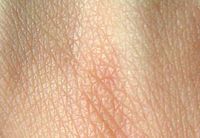
Photo from wikipedia
Pemphigus is a chronic autoimmune skin blistering disease, characterized by acantholysis and by the production of autoantibodies directed against the structural desmosomal proteins desmoglein 1 (DSG1) and/or DSG3. Model systems… Click to show full abstract
Pemphigus is a chronic autoimmune skin blistering disease, characterized by acantholysis and by the production of autoantibodies directed against the structural desmosomal proteins desmoglein 1 (DSG1) and/or DSG3. Model systems allow the identification and testing of new therapeutic targets. Here, we evaluated ultrastructural desmosomal morphology in the human skin organ culture (HSOC) model injected with either anti-desmoglein (DSG) 1/3 single-chain variable fragment (scFv, termed Px4-3), Staphylococcus aureus exfoliative toxin (ETA) as a reference and positive control, and normal human IgG as a negative control. Each experimental condition was evaluated in abdominal skin biopsies from five different donors. After 24 h of incubation, we processed the samples for histological and ultrastructural electron microscopy analyses. We found that Px4-3 or ETA induced a loss of desmosomes and increased interdesmosomal widening, similar to patient skin biopsies and other pemphigus models. Thus, we propose the HSOC pemphigus model as an attractive tool to unravel novel therapeutic targets.
Journal Title: Frontiers in Medicine
Year Published: 2022
Link to full text (if available)
Share on Social Media: Sign Up to like & get
recommendations!